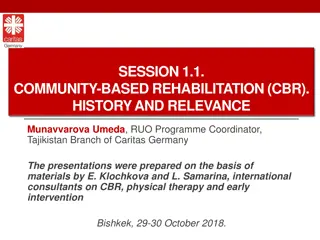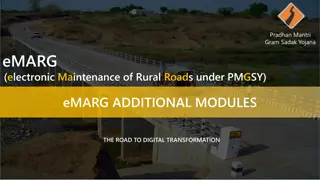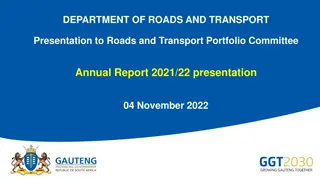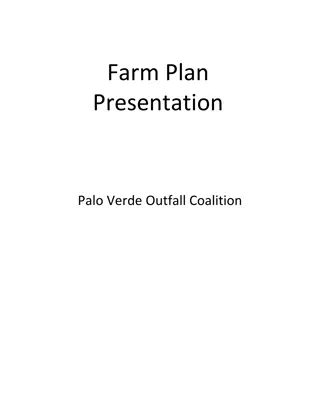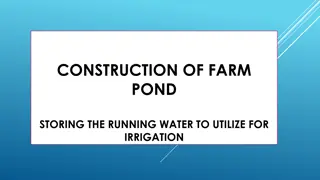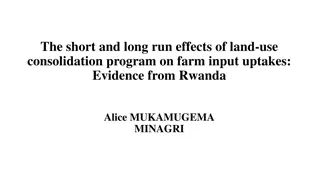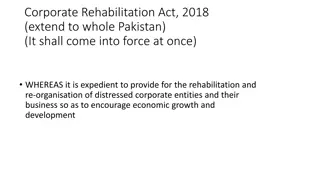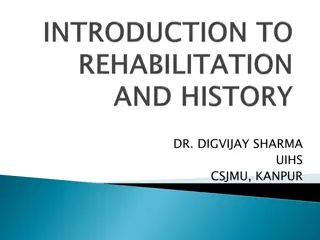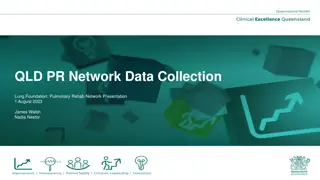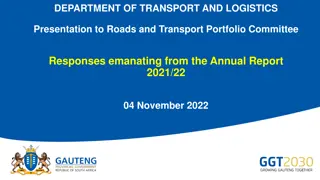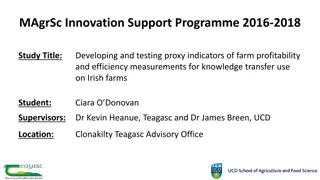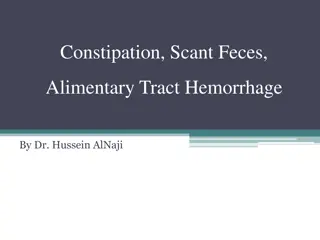Analysis of RADA's Farm Roads Management and Rehabilitation Performance
RADA is responsible for maintaining Jamaica's farm roads island-wide. The audit assessed the effectiveness of the management system for rehabilitating farm roads and the quality management. Budget allocations for farm road rehabilitation had limitations, with a lack of transparency and accountability in the budget process. RADA's Strategic Business Plan did not consistently align with funding requests from MICAF, raising concerns about fund diversion approval.
Download Presentation

Please find below an Image/Link to download the presentation.
The content on the website is provided AS IS for your information and personal use only. It may not be sold, licensed, or shared on other websites without obtaining consent from the author. Download presentation by click this link. If you encounter any issues during the download, it is possible that the publisher has removed the file from their server.
E N D
Presentation Transcript
RADA RADA S S MANAGEMENT MANAGEMENT OF OF THE REHABILITATION REHABILITATION OF THE OF FARM FARM ROADS ROADS PERFORMANCE AUDIT REPORT
Key Data Key Data RADA is responsible for maintaining farm roads island wide RADA is the implementing agency for the Farm Road Rehabilitation Programme (FRRP), since October 2015 Jamaica s farm road network is estimated at 1,500 km.
Purpose of the Audit To assess whether the GOJ, through RADA, had in place an effective management system for the rehabilitation of Jamaica s farm roads To assess the effectiveness of the quality management of farm roads
GOJs Vision for Jamaicas Farm Roads Agriculture s Contribution to Jamaica s Sustainable Development (2010) UN Sustainable Development Goal Vision 2030 National Development Plan (NDP) The National Transport Policy (2007) # 9 Investment in agricultural research and rural roads typically produces returns that are two to six times greater than those produced by providing input subsidies. To improve and rationalize the road network including farm road network by improving agriculture feeder road. Investment in infrastructure and innovation are crucial drivers of economic growth and development. Transport vital for human development, in terms of access to markets and basic services.
Trend Analysis of RADAs Farm Roads Rehabilitation Programme 1,600,000 120.00% 1,500,000 1,400,000 100.00% 1,200,000 80.00% 1,000,000 800,000 60.00% 600,000 24.69% 40.00% 400,000 20.00% 200,000 0 0.00% 2015-2016 2016-2017 2017-2018 2018-2019 Budget Request $ ('000) 500,000 300,000 1,500,000 834,720 Budget Allocation $ ('000) 459,747 250,000 470,000 800,000 Amount Received $ ('000) 452,747 257,684 370,367 759,417 Amt. received as % of requested 90.55% 85.89% 24.69% 90.98% Amt. received as % of Allocation 98.48% 103.07% 78.80% 94.93% Budget Request $ ('000) Budget Allocation $ ('000) Amount Received $ ('000) Amt. received as % of requested Amt. received as % of Allocation Linear (Amount Received $ ('000))
KEY FINDING: RADAs budget request for the management of farm roads was limited to the Farm Road Rehabilitation Programme (FRRP) RADA s Strategic Business Plan (SBP) Annual Budget Requests Diversion of Funds RADA s annual funding requests were limited to the rehabilitation of 50 km of priority roads under the FRRP. Budget submissions and plans did not include funding for routine, preventative & emergency repairs. There was no consistent relationship (alignment) between RADA s budget outlined in the SBP and that requested from MICAF No reasons provided for the difference, which limited transparency of the budget process and accountability. RADA failed to provide evidence that MICAF approved the diversion of funds allocated for farm roads, towards the repair of non-farm roads.
KEY FINDING: KEY FINDING: RADA could not readily distinguish between farm roads and the parochial roads managed by municipal corporations. RADA admitted that its definition of farm roads was inadequate and outdated. RADA established annual priority lists for the selection of farm roads to be rehabilitated but could not explain the basis for the selection of some farm roads This raised doubts regarding the transparency of the selection process.
Key Finding: RADA could not identify which of the following criteria the roads on its priority list satisfied. RADA advised that the lack of financial and human resources hampered their ability to measure the economic impact of the farm road rehabilitation. In the interim, sensitization sessions were initiated during its quarterly performance review meetings, in order to give senior management an appreciation of the importance of impact evaluation.
Key Finding: RADA lacked a proper roads management system to support its road rehabilitation programme. A robust road inventory management system would provide information necessary for the proper determination and prioritization of resources including the current status of farm roads, to guide the rehabilitation activities. RADA intends to develop a system that would identify roads by (GPS), distance, condition of surface, drainage, estimate of works to be done, number of farmers served, agricultural production in the area (type of enterprise, hectarage in use and output) and expected impact of the rehabilitation investment among other demographics.
Key Finding: RADAs process of selecting contractors was not always transparent or competitive. RADA was unable to indicate the basis on which the contractors engaged by LT methodology were pre-selected for invitation to bid on road rehabilitation contracts. $1b $521m $91m 75 contracts awarded by inviting pre- selected contractors 4 contracts awarded on competitive basis 33 contracts awarded directly or for emergency
Key Finding: RADAs process of selecting contractors was not always transparent or competitive. RADA s justification for the use of the direct and emergency procurement methodologies did not conform with GOJ guidelines. The reasons cited by RADA were: The need to expend the budgetary allocation for the farm road rehabilitation programme before the end of the financial year The impact of land slippage and deterioration of the road surface due to continuous rainfall over the past 4 to 6 months The selected contractor was already mobilised and engaged on similar projects in the parish or neighbouring parishes The contractors possessed the necessary expertise and capability to perform the works satisfactorily and within budget
Key Finding: RADAs omission of critical specifications from road rehabilitation contracts, coupled with the absence of routine and regular maintenance, heightened the risk of sub-standard works. RADA frequently re-scoped road works by excluding elements such as drains and culverts, deemed key components of road infrastructure that could ensure its longevity. RADA also changed the location of contracted works without any evidence of re-measurements. Survey of farmers revealed that while some acknowledged that repaired roads made it easier to get to and from their farms and reduced wear and tear on their motor vehicles, many complained of poor drainage on some newly rehabilitated roads.
Key Finding: RADAs inspection and monitoring activities were inconsistent with its quality assurance framework. Works engineers made no notations on inspection checklists regarding the nature, frequency of testing and physical conditions of the roads during monitoring and inspection. RADA developed guidelines related to key quality requirements for general work activities along with an inspection checklist. RADA s Internal Audit Reports highlighted issues that supported AuGD s concern that RADA did not take steps to assure itself that roads were rehabilitated to quality standards.
Recommendations RADA needs to align its strategic plan to embrace routine, preventative and emergency repairs. RADA should consider implementing a road inventory management system for roads under its purview. GOING FORWARD RADA should review its current systems to ensure adherence to quality standards and guidelines, related to its road works. RADA should consider coordination with PIOJ and STATIN to enable the measurement of the economic impact of road rehabilitation.









